Introduction
The Mk 48 torpedo is a highly sophisticated 21-inch (533 mm) submarine-launched weapon designed for both anti-submarine and anti-ship roles, making it one of the most complex torpedoes ever developed. The Advanced Capability (ADCAP) variant remains the U.S. Navy’s sole submarine-launched torpedo, deployed across all U.S. submarines, including strategic missile submarines, serving as a critical self-defense weapon.
Introduced in 1972, the Mk 48 replaced the Mk 37 torpedo and the Mk 45 ASTOR (Anti-Submarine Torpedo), establishing itself as the universal torpedo for U.S. submarines. Conceived in the mid-1950s during the pre-digital era, the Mk 48 was pioneering in its use of multi-speed propulsion. This innovative design allowed the torpedo to achieve high transport speeds while wire-guided, then reduce speed to effectively home in on its target.
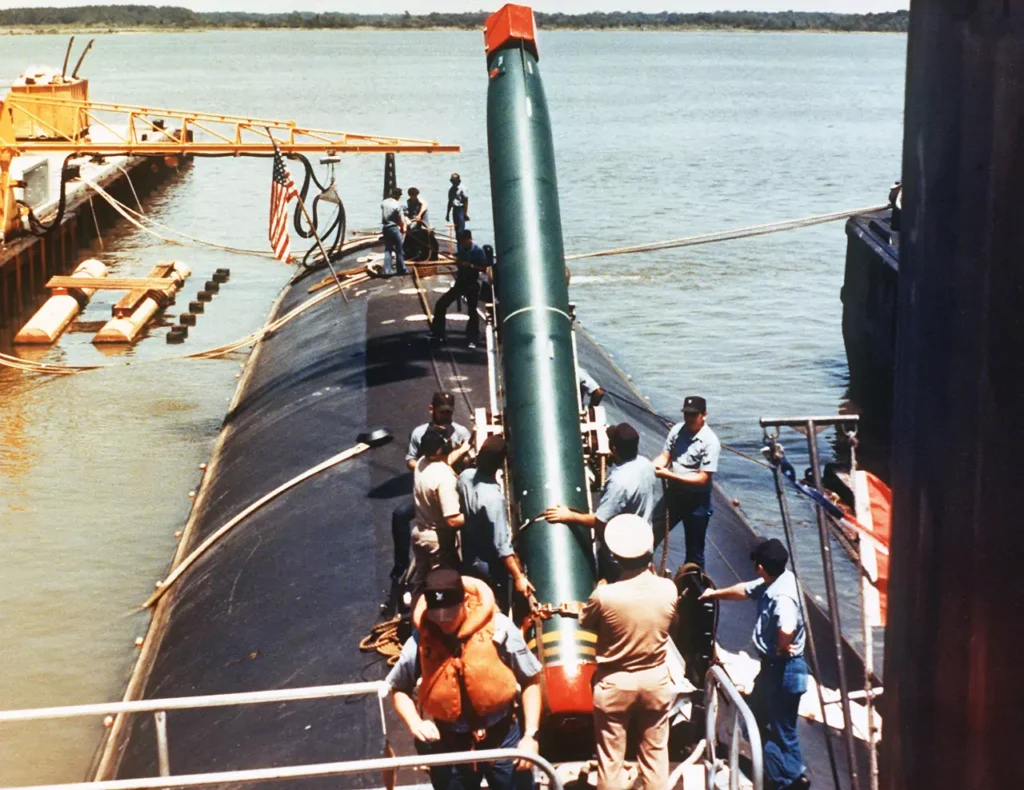
Before its introduction, the Mk 48 underwent the most extensive underwater weapon system evaluation ever conducted by the U.S. Navy, including 227 range runs of the Mod 1 variant and a total of 300 runs across Mods 0 and 2.
Today, the Mk 48 serves as the primary armament for both nuclear-powered hunter-killer submarines (SSNs) and strategic missile submarines (SSBNs), effectively countering fast, deep-diving nuclear submarines and high-performance surface ships.
Development
Description
Externally, the Mark 48 is a long slim cylinder with a flat nose and four fin-like wire dispensers faired into the afterbody ahead of the shrouded and axial flow pump-jet propulsor. Internally it consists of a nose group, warhead group, control group, fuel tank group, and afterbody.
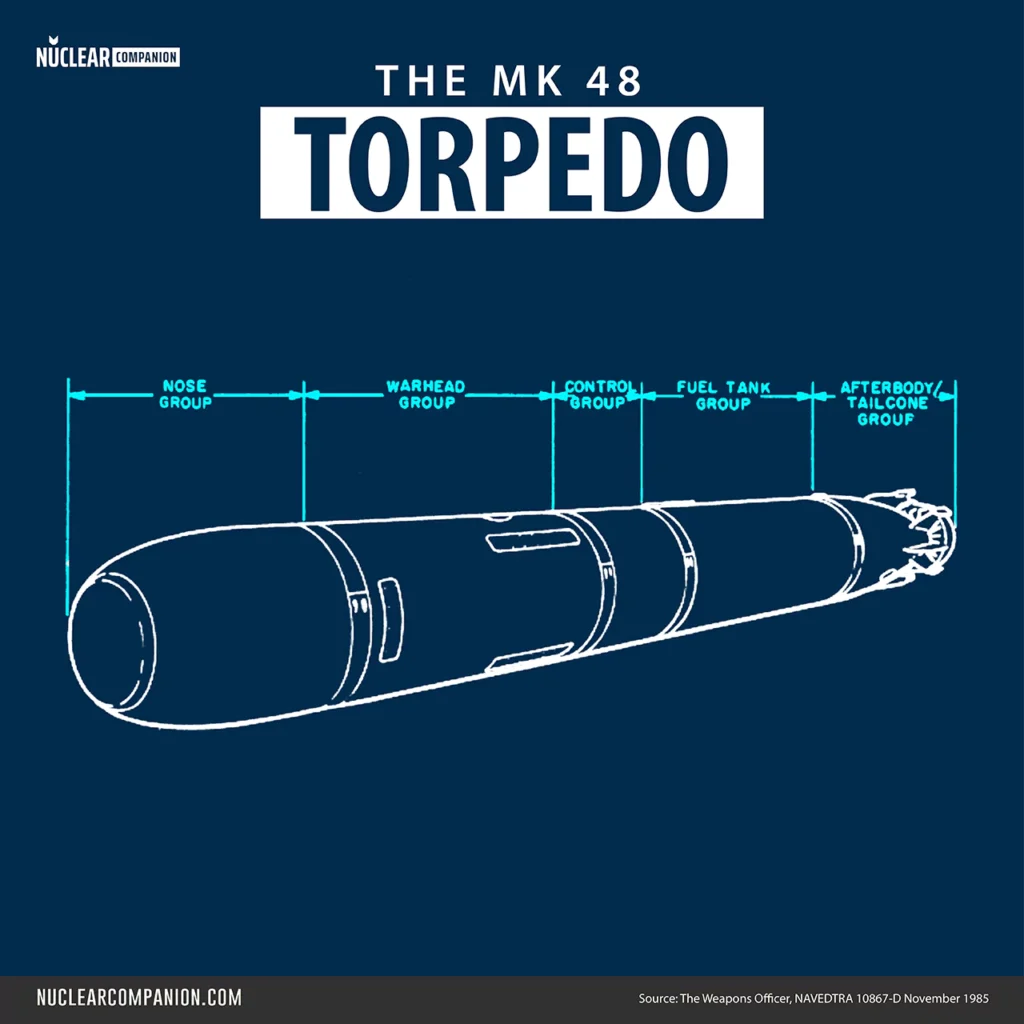
Nose Group
The nose group consists of the Mark 72 transducer, the Mark 83 transmitter, the Mark 68 receiver, and the Mark 1 Homing Control Logic (HCL). The transducer unit is in the front of the nose to transmit and receive acoustic signals, the acquisition range being 2 n miles (3600 m).
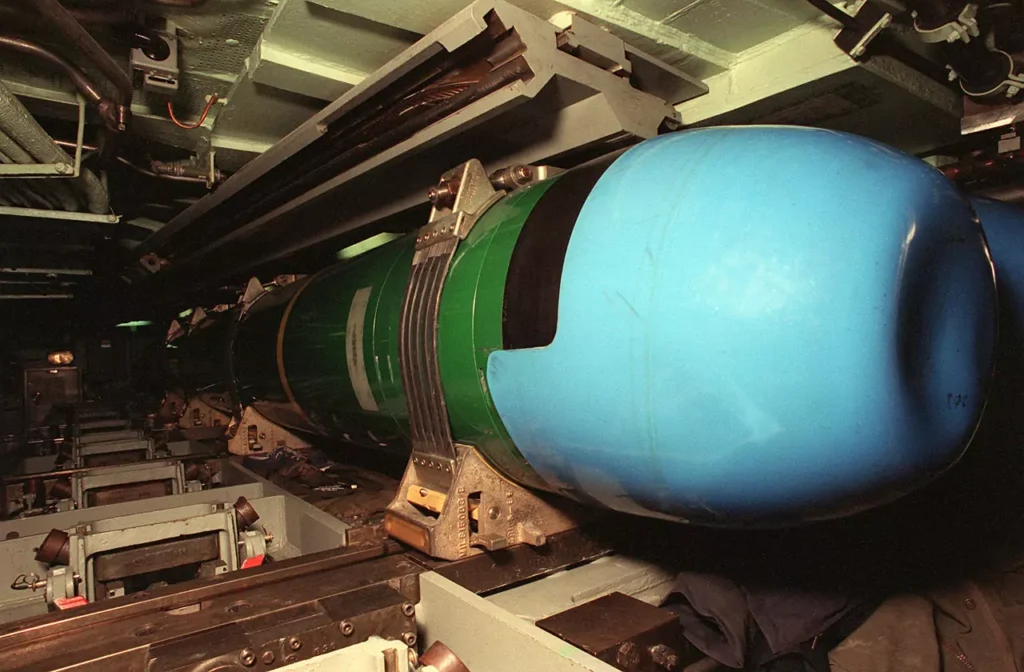
The receiver in the lower half of the nose group processes acoustic data and determines the target location relative to the transducer in order to generate steering commands. The HCL at the rear of the nose group and above the receiver contains the computer that directs torpedo maneuvers in the search, homing, and re-attack modes. It is also used to analyze all acoustic signals for valid target returns.
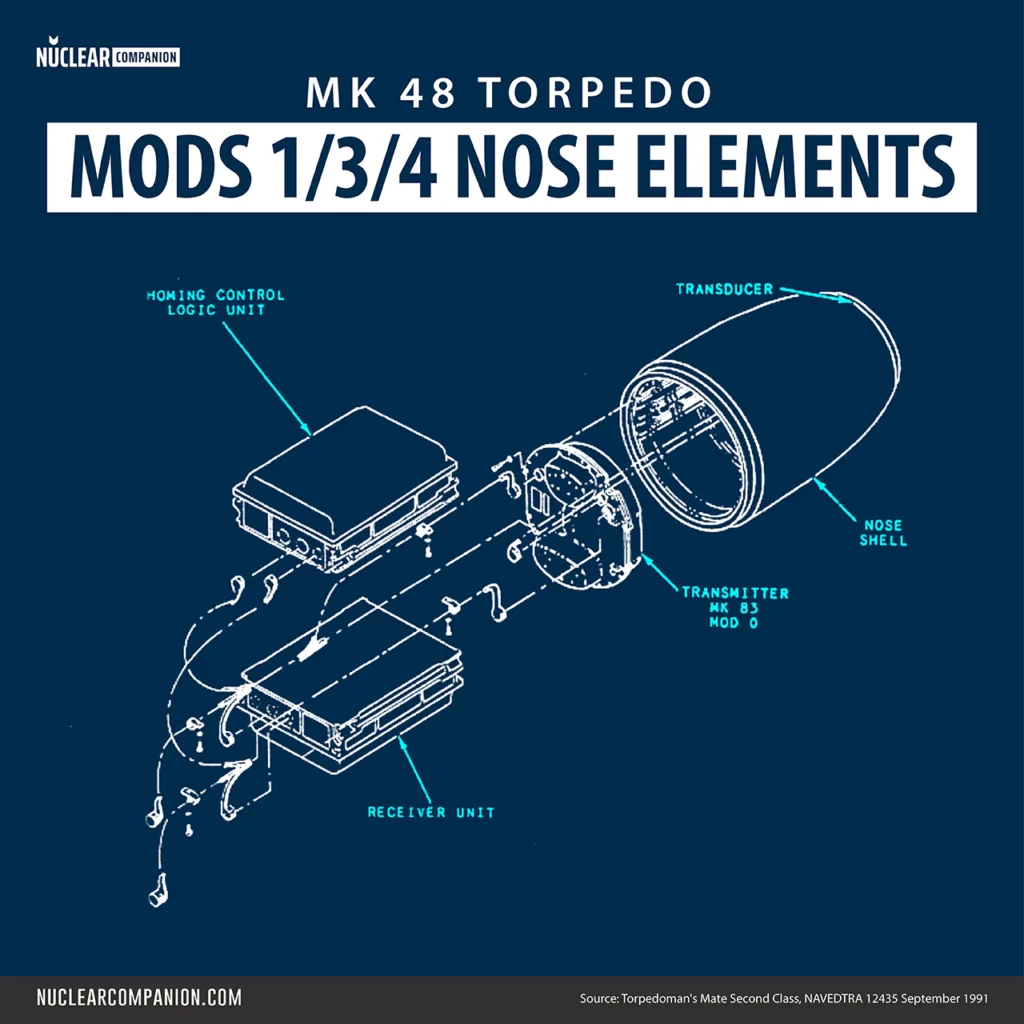
Warhead Group
The warhead group consists of the Mark 107 PBXN warhead, the Mark 21 exploder, the Mark 2 arming device, and the Mark 12 electronic assembly. The 292.5 kg warhead has the Mark 21 and the Mark 2 within it, the fuze possessing contact and long-/short-range proximity functions. The Mark 12 electronic assembly at the rear of the compartment contains target detection electronics that detonate the warhead. For training purposes, this is replaced by a fleet exercise section provided by Dewey Electronic Corporation.
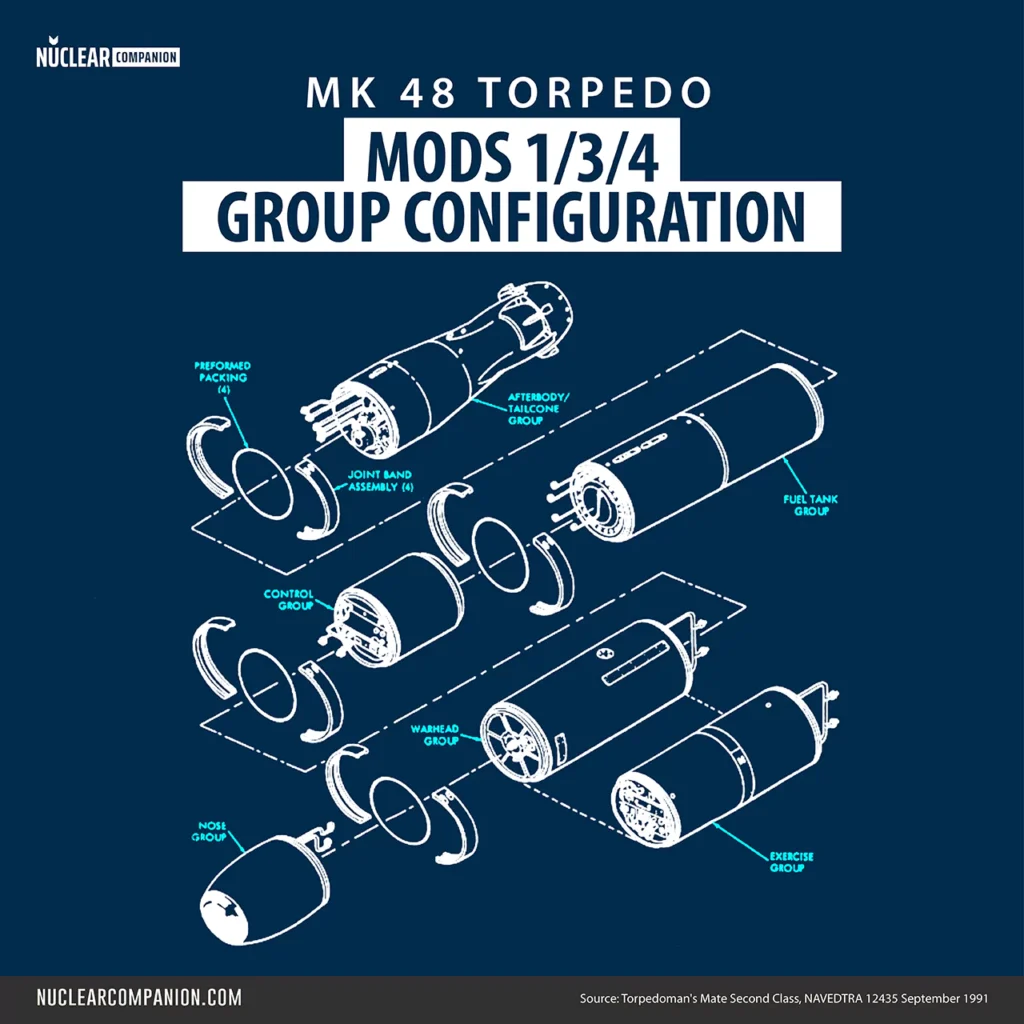
Control Group
The control group consists of either the Mark 154 or Mark 168 command control unit, the Mark 155 gyro control unit, and the Mark 156 Power Control Unit (PCU). The command control unit in the lower third of the compartment implements fire control instructions, maintains the torpedo at the commanded speed, and monitors the depth to ensure the weapon stays within the commanded maximum and minimum depth limits. The gyro control unit in the center of the compartment converts steering commands into fin deflection signals while the PCU controls the speed of the weapon.

Fuel Tank and Afterbody
The fuel tank group houses not only the Otto monopropellant fuel (968 lbs. / 439 kg) but also the wire dispenser used for command guidance after launch. The afterbody contains the 500 hp external combustion gas piston engine, steering control surfaces, and engine accessories. The grain-loaded combustion chamber and alternator are mounted on the forward bulkhead with the alternator assembly.
Torpedo Operation
The Mk 48 torpedo employs a sophisticated system operation designed to ensure maximum effectiveness against fast, deep-diving submarines and high-performance surface ships.
Launch and Initial Guidance
When launched, the torpedo begins its mission by executing a series of target search, acquisition, and attack procedures. If it misses the target on the first attempt, it is capable of executing multiple reattacks until the target is neutralized.
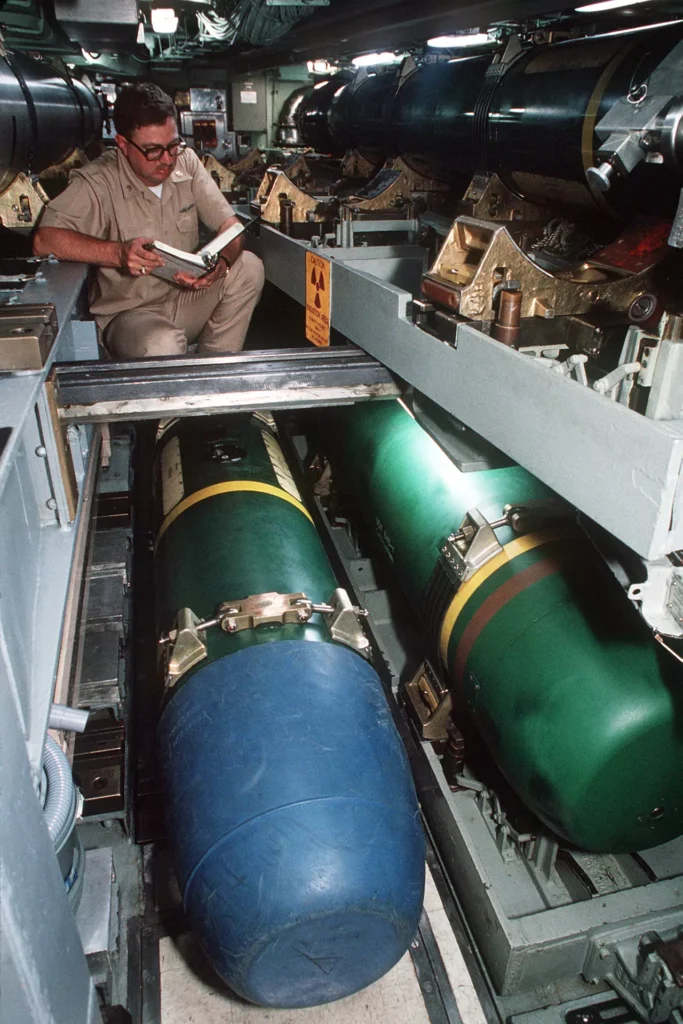
Upon launch, the Mk 48 is propelled by hydraulic impulse, which initiates its engine. The torpedo streams a wire back to the launching submarine, allowing the fire control equipment to monitor its course, speed, and depth.
Initially, the torpedo follows a pre-set gyro course, which directs it toward the target. The wire guidance system only comes into play if adjustments are needed due to changes in the target’s position and movement after launch. In such cases, the fire control technician can override the torpedo’s gyro course via the wire guidance to correct its trajectory.
The Mk 48 uses multi-speed propulsion to enhance its operational efficiency. During the initial phase, it travels at a high transport speed, guided by the wire, to quickly close the distance to the target. This high speed generates noise, making it less effective for sonar detection.
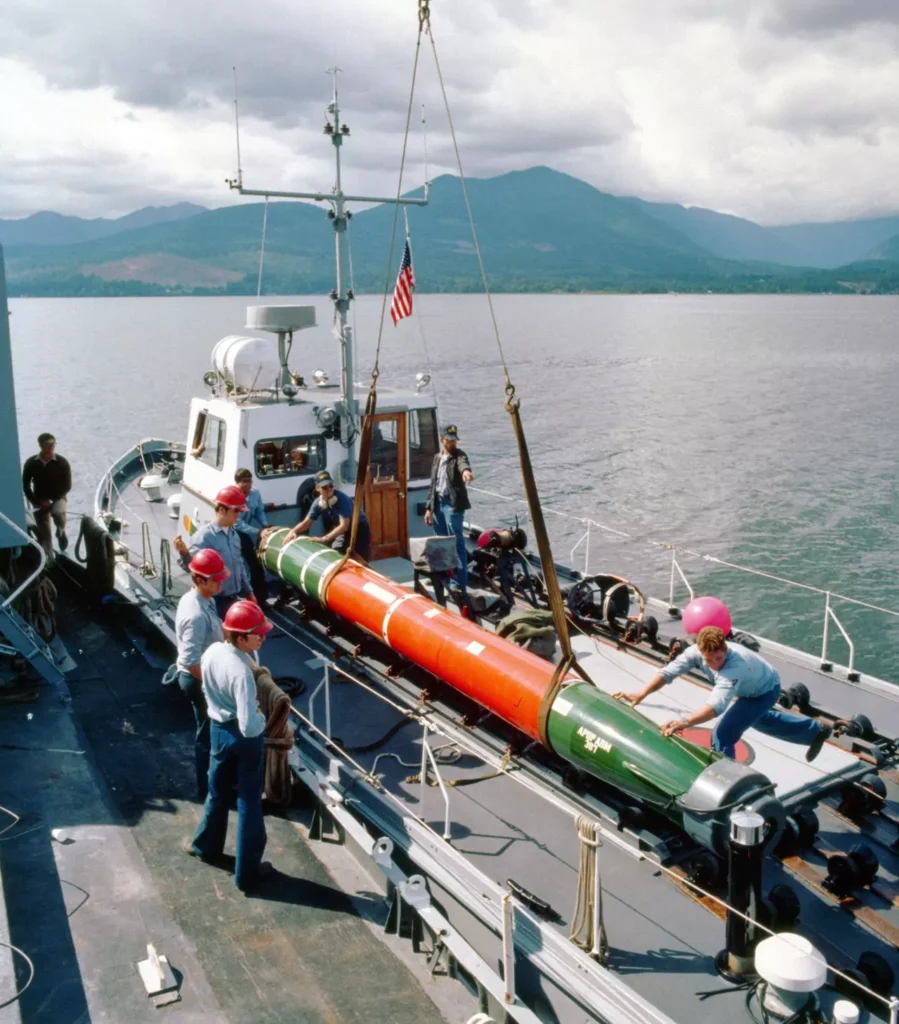
Sonar Activation and Target Engagement
However, once the torpedo reaches a point where its sonar can assume control, it slows down to homing speed. This reduction in speed is crucial as it allows the torpedo’s acoustic sensors to distinguish target echoes from the noise of water flowing around its array.
As the torpedo begins to “ping,” or emit sonar pulses, it needs to operate at a low enough speed to detect and interpret the echoes effectively. The submarine continues to wire-guide the torpedo into the optimal position, ensuring it remains on the correct path.
Once the torpedo is close enough to the target, the strength of the echoes increases, and the need for precise listening diminishes. At this stage, the torpedo can accelerate again to make evasion difficult for the target.
Variants
Mark 48 Mod 0
Mod 0 was an ASW-only system. The propulsion system consisted of a turbine engine and a pump jet propulsor. It was considered not ready for production.
Mark 48 Mod 1
The Mk 48 Mod 1 torpedo was a dual-purpose antisubmarine and antiship weapon. It featured a redesigned acoustic homing guidance system and was powered by a 500 hp axial-flow liquid-propellant swash-plate pump-jet engine.
This piston-type swash-plate engine used Otto II fuel, a liquid monopropellant consisting of nitrogen ester and hydroxylamine perchlorate. The torpedo was equipped with a 650-pound warhead, providing significant explosive capability compared to Mod 0.
Mark 48 Mod 2
This was also is a dual-purpose antisubmarine and anti-ship weapon. It was a conversion of the basic Mk 48 Mod 0 torpedo that enhanced its effectiveness against surface ships.
To kill large surface combatants, the Mod 2 used the remaining propulsion fuel to augment the warhead explosion. Additionally, it incorporated an upward-looking acoustic system for stand-off capability.
Mark 48 Mod 3
This variant incorporated feedback telemetry status of torpedo functions, a shipboard display of torpedo depth and azimuth trajectories, and an anti-self-homing shutdown circuit.
The two-way telemetry system, known as TELCOM (telemetry communication) allowed the torpedo to send sonar data back to the submarine for processing and provided the operator with target detection, target Doppler, and torpedo-homing information.
TELCOM transmitted 14 torpedo and target parameters each second, enabling the operator to exploit the torpedo’s sonar. An automatic scanning and torpedo preset selection system was also included.
The Mod 3 torpedo was certified and introduced into the fleet in 1977.
Mark 48 Mod 4
The Mk 48 Mod 4 torpedo was an upgrade to enhance capability against the advanced Soviet Alfa-class SSNs. Known as the near-term upgrade, it served as a short-term solution before the deployment of the ADCAP variant.
While it did not change acoustic acquisition or homing capabilities, the Mod 4 allowed for deeper operation and better recognition of faster targets.
Testing showed the Mod 4 could target depths thirty percent beyond previous specifications without altering the torpedo hull structure. Additionally, changes to the comb filter in the homing control logic increased the outer limits of target Doppler detection by about twenty-five percent.
The first Mk 48 Mod 4 was delivered to the fleet in January 1981. Some 520 of this version, with both Telcom and a fire-and-forget mode, were produced mostly in kit form.
Mark 48 Mod 5 Advanced Capability (ADCAP)
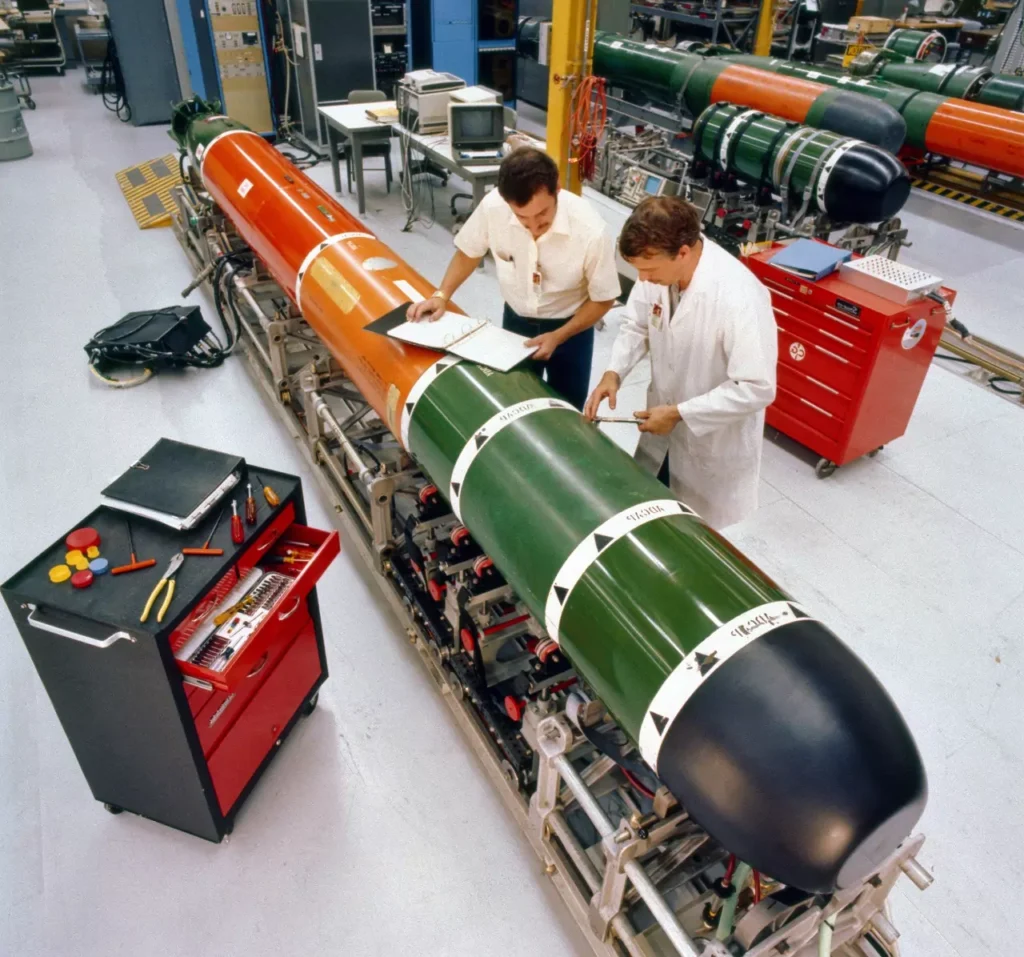
The Mark 48 ADCAP (Advanced Capability) was developed to enhance the effectiveness of the earlier Mark 48 mod 3 & 4 against advanced adversarial submarines, such as the Soviet Alfa class, capable of speeds up to 40 knots. Initiated in the mid-1970s and authorized for full production in 1990, the ADCAP featured increased speed, endurance, and accuracy.
It incorporated a swashplate engine with higher fuel capacity, a compact computer, and advanced sonar, guidance, and control systems. Digital technology allowed ongoing upgrades to counter evolving threats. The last new ADCAP was delivered in 1996, but performance enhancements continue on existing inventory. IOC in 1988;
Mark 48 Mod 6 Advanced Capability (ADCAP)
The MK 48 Mod 6 ADCAP introduced two major upgrades over the Mod 5: enhancements to guidance and control (G&C) and the torpedo propulsion unit (TPU). The G&C improvements included a better acoustic receiver, updated technology, increased memory, and faster processing to handle advanced software for improved threat performance. The TPU upgrade significantly reduced the torpedo’s radiated noise signature.
The Mod 6 reached IOC in 1997; the latest improvements were fielded in 2009.
Mark 48 Mod 7 Common Broadband Advanced Sonar System (CBASS)
The Mk 48 Mod 7 was specifically designed to target slow diesel submarines using countermeasures in littoral environments.
It was co-developed under a 10-year Armaments Cooperative Project (ACP) agreement with the Royal Australian Navy, signed in March 2003, for use in its Collins-class submarines.
It included a new Broadband Sonar Analog Receiver (BSAR) and processing algorithms to enhance counter-countermeasure and shallow-water performance while retaining deep-water capabilities. It also replaced obsolete electronic components with Commercial Off-The-Shelf (COTS) processors, increasing processing capacity.
The first in-water runs of the CBASS were conducted in September 2004 in Australian waters, and the torpedo reached Initial Operational Capability (IOC) in FY 2006.
Production
| Year | Mk 48 Units Produced |
|---|---|
| Up to 1980 | 3059 |
| FY80 | 144 |
| FY81 | 144 |
| FY82 | 144 |
| FY83 | 144 |
| FY84 | 144 |
| FY85 | 108 |
| Year | ADCAP Units Produced |
|---|---|
| FY85 | 30 |
| FY86 | 123 |
| FY87 | 50 |
| FY88 | 100 |
| FY89 | 320 |
| FY90 | 260 (cut from 320 requested) |
| FY91 | 240 (cut from 320 planned) |
| FY92 | 108 |
| FY93 | 108 |
| FY94 | 108 |
Operative service
As of mid-1995, the U.S. Navy had about 4000 Mk 48/ADCAP on hand, of which 3000 were active (about 1000 ADCAP and 2000 Mk 48 [mostly Mod 4]), but with the decline in submarine numbers only about 2000 were needed.
Users of the Mk-48 torpedo besides the United States are: Australia, Canada, Netherlands and Turkey.
Specifications
Mk 48 Mod 4 specification
| Length | 230 inches (5.8 m) |
| Diameter | 21 inches (533 mm) |
| Weight | 3480 pounds (1579 kg) |
| Propulsion | Positive displacement piston-type engine |
| Guidance Homing | Gyro, wire Active, passive, combination acoustic |
| FC Settings | Electrical |
| Warhead | Mk 107 - 650 lbs. (295 kg) of High Explosive PBXN-103 |
| Exploder | Mk 21 Mod 0 |
| Max Speed | 55 knots (102 km/h) |
| Max Depth | 2,490 ft (760 m) |
| Max Range | 17.4 n miles (32.2 km) |
Mk 48 ADCAP specification
| Length | 230 inches (5.8 m) |
| Diameter | 21 inches (533 mm) |
| Weight | 3500 pounds (1587 kg) |
| Propulsion | Piston engine; Pump jet |
| Warhead | Mk 107 - 650 lbs. (295 kg) of High Explosive PBXN-103 |
| Max speed | 65 knots (120 km/h) |
| Max depth | 2950 ft (900 m) |
| Max range | 24.5 n miles (45.75 km) |
Further reading
- United States Submarine-Launched Ballistic Missiles (SLBM)
- Ohio-Class (SSBN-726) Ballistic Missile Submarines
Bibliography
- Dalgleish, D. D., Schweikart, L. (1984). Trident. United States: Southern Illinois University Press.
- Jane’s Major Warships. (1997). United Kingdom: Jane’s Information Group.
- Polmar, N. (2013). The Naval Institute Guide to the Ships and Aircraft of the U.S. Fleet. United Kingdom: Naval Institute.
- Saunders, S., Philpott, T. (2015). Jane’s Fighting Ships 2015-2016. United Kingdom: Jane’s Information Group.
- Sea Power for a New Era: Program Guide to the U.S. Navy. (2007). United States: Department of the Navy.
- Friedman, N. (1997). The Naval Institute guide to world naval weapons systems. Annapolis: Naval Institute Press.
Amazing. Toluene technical exposure.
Just when the unknowns of Otto fuel II exposure are still undeniably unknown.
I’m a science project to my doctors today.
I worked on this torpedo scence the 48 phase/mod 3 and ended up in the ADCAP program.
William Zacharo. Aka Bill.. Z. Raytheon POS. Traitor. I have two Half full of shipmates that made you.
Admirial Dennis Holt. Ok I found a different way to find you.. CE04 You are a great leader and good friend. It’s an honor to me to be your first pick of trust.
Denny Bierman. may you rest in peace .
To the host of this website. Find us all.
And your China. This guy has one call friends!
TM1 (SW) Larry Partain USN Retired.
Hi Larry, thank you very much for sharing your thoughts and honoring your shipmates here. I deeply appreciate your service and sacrifice, and your message encourages me to keep these important memories alive.
My father developed Mods 1 thru 4.
I wish his name could be on hear.
I have a letter from NSWC in White Oak Maryland saying so.
Richard K. Kreiger?
Did you know of him?